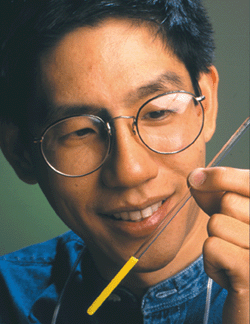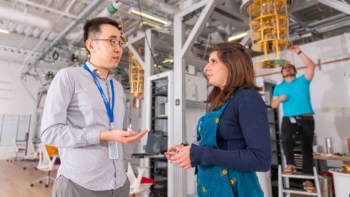Science and technology could be revolutionized by quantum computers, but building them from solid-state devices will not be easy. Robert W Keyes of IBM's research division outlines the challenges in scaling up the technology from lab experiments to practical devices.

Quantum processing is a fascinating new approach to computing that has attracted great attention in recent years. Much of this interest has stemmed from the discovery of non-classical quantum algorithms that could allow otherwise intractable problems – such as factoring very large numbers – to be solved.
In quantum computing the straightforward sequences of binary digits or “bits” that have served computing well for over half a century are abandoned. A working quantum computer uses a physical system that can be in either of two quantum states – representing “0” and “1” – known as quantum bits or “qubits”. But quantum mechanics also allows these qubits to be placed in a superposition of the two states. In principle, therefore, a superposition of the states of a large collection of qubits can contain an enormous amount of information.
Quantum computing directs the evolution of the superposition towards a final state that contains a result that depends on all of the original information, such as a number to be factored. Unwanted interactions (other than those between the qubits) interrupt the planned evolution of the wavefunctions and are known as “decoherence”.
A powerful quantum computer that could realize the remarkable potential of quantum computing would need at least many thousands of qubits. So how would we build such a device? The obvious solution is to turn to solid-state technology, which is a well-established method for making large numbers of complex small devices. Many researchers are already following this path and are carrying out work on solid-state qubits that has – as a bonus – opened up many new areas of physics. In particular, experiments aimed at creating qubits have helped us to understand the interface between quantum mechanics and the macroscopic world.
Although this research is to be encouraged, I believe that the obstacles in the path to achieving a large quantum computer have been too hastily dismissed. The 40-year history of electronic technology for computers suggests that it will be hard to make a large number of devices that are sufficiently alike to meet the rigorous demands of quantum computing. The problem is that nominally identical solid-state qubits are likely to be physically different. While some physicists have recognized this difficulty, I think that many others have not fully appreciated that these differences may limit – or even prevent altogether – a collection of qubits from working as a quantum computer.
Quantum computing in solution
All quantum-computing experiments to date have used qubits made from atomic nuclei, which are relatively isolated from their environment and therefore have some protection against decoherence. The most advanced quantum computer built so far was constructed last year by Isaac Chuang and his colleagues at Stanford University and IBM’s Almaden Research Center in California. Chuang and his co-workers managed to factor the number 15 using a solution of specially synthesized molecules containing seven spin-half nuclei (see Quantum computers get real (summary) by Jonathan Jones Physics World April pp21-22, print version).
The seven nuclei served as qubits when a magnetic field was applied to the molecules to create two distinguishable states. The nuclei interacted with one another through their contact with the electronic wavefunction of the molecule, while the orientations of the nuclei were manipulated using the well-established technique of nuclear magnetic resonance (NMR) spectroscopy.
By exposing the molecules to a sequence of accurately timed pulses of radio waves at carefully chosen frequencies, Chuang’s team was able to prepare some of the molecules – each of which served as a quantum computer – into a desired initial state. Further sequences of pulses served as quantum logic gates that caused the nuclei to interact to produce a logical result, in this case the factors of the number 15.
These computations with molecules in solution were a real tour de force that relied on the extraordinary precision of NMR technology. Frequencies of hundreds of megahertz were selected with a resolution of just a few hertz, while the magnetic field had to be homogeneous to within one part in a billion. The timing of the interactions and the pulse shapes of the high-frequency radiation also had to be rigorously controlled.
From solutions to solids
Scientists believe, however, that computation using atomic nuclei in molecules will be limited to very few qubits – perhaps ten at most. The problem is that extending quantum computation from atomic nuclei in molecules to atomic nuclei in solids will not be easy. Ever since the integrated circuit was invented in the 1950s, the electronics industry has developed increasingly sophisticated methods for fabricating small, complex structures. Materials are heat treated, exposed to reactants and deposited on substrates. However, it is difficult to make accurately reproducible structures with these techniques. Tiny variations in the temperature across a substrate, for example, can lead to differences between nominally identical devices on the substrate. Differences between the thermal expansion of materials that have been bonded together can strain the substrate and change the characteristics of the devices.
A real solid that has been processed for an electronic application is, in other words, quite different from the ideal crystal of solid-state theory. Its properties will differ from one device to another and it will possess characteristics that are known only to within certain finite limits. Solid-state devices will not be able to duplicate the high-precision calculations that have been possible with molecules and NMR.
These problems do not, of course, affect conventional digital logic, which can cope with the imperfections of material objects. A hole in a punched card, for example, is not rendered unreadable by wear that increases its size. A relay contact is either open or closed and its conductivity does not need to be accurately known. The silicon transistors of modern electronic devices make connections to potentials the values of which represent zero and one throughout a system. The transistor acts as a switch and needs no fine-tuning.
Despite the challenges posed by solid-state qubits there has been no shortage of ideas about how to make them. Many proposals based on silicon have been put forward. Some use the spin of nuclei in a magnetic field, while others use the spin of electrons. Solid-state qubits using superconducting devices based on quantum effects first predicted by Brian Josephson in 1962 are also being explored.
All of these qubits contain elements used in integrated electronics, such as thin films, metal electrodes and different kinds of materials. Their behaviour is controlled by voltages applied to the electrodes, with the size and placement of the electrodes – and the underlying material structure – affecting the performance of the qubits. The uncertainty in the properties of these physical elements means that responses to the signals applied are also uncertain.
The unpredictable variability in the properties of qubits makes them difficult to use in a system with a continuum of choices. The signals required to control the qubits and their interactions will vary from device to device and from place to place on a substrate. The NMR computing experiments succeeded only because they relied on precisely timed pulses of high-frequency radiation. There is little hope of achieving the same accuracy with solid-state devices the parameters of which may be known to only within a few per cent.
Tackling the problems
Although these differences between nominally identical solid-state devices are known in the quantum-computing community they are regarded more as a minor irritant than a major limitation on the performance of hardware. Some researchers have suggested that the variability of solid-state hardware could be overcome by fine-tuning each device’s properties using appropriate voltages. However, these “biases” delivered through other solid-state devices will be imperfect and differences between devices intended to be identical will remain.
Conventional silicon electronics encounters the limits of devices with imperfectly known properties when it attempts to represent information in other than strict binary form. A bit in memory is represented by the presence or absence of charge on a capacitor. Engineers have long sought to store more than one bit on the capacitor. In theory this could be achieved by measuring the charge and expressing the amount as a sequence of binary digits. For example, if 16 levels of charge could be distinguished then four bits of information could be stored.
The quest has long been unsuccessful because the circuits that place charge on the memory capacitor and analyse the removed charge are not perfect. The charge leaks away with time and storing more than one bit has proved impossible. The development of non-volatile RAM – so-called flash memory – has recently led to the successful storage of two bits, or four levels of charge, on a single capacitor. The question of how much information can be contained in superpositions of states of randomly different qubits can contain also demands attention.
Decoherence is justly recognized as a serious threat to quantum processing. The currently accepted solution is to use more than one qubit to represent one bit of information (see “Decoherence: the obstacle to quantum computation” by David DiVincenzo and Barbara Terhal Physics World March 1998 pp53-57, print version only). Encoding each bit in several qubits would, however, require much more hardware. Much more processing for the comparisons that detect and correct errors would also have to be carried out. Unless processing is almost error-free then the process will not converge. Estimates of the permissible probability of error vary from 10-6 to 10-4. Can solid-state devices meet this challenging target?
Since only a few single solid-state qubits have so far been realized no experiments have examined the interactions of qubits. The duration of an interaction must change the affected qubit by just the right amount. Accurate timing and shaping of the pulses that controlled the interactions of qubits were difficult parts of the NMR computations. Uncertainty in the properties of solid-state qubits will make proper timing of the interactions between them much harder.
Quantum futures
Quantum computing is, in principle, possible. But how can we build a system with tens of thousands or more of qubits? Solid-state devices are the most promising answer, but the devil is in the detail. Making many solid-state qubits all perform a prescribed function with high accuracy is thwarted by one device never having exactly the same characteristics as the next. Dealing with devices with imperfectly known characteristics poses questions that remain unanswered and sometimes even unasked.
The fundamental question is how much information can be contained in a superposition of the wavefunctions of qubits when the properties of those qubits are known with limited precision? In spite of much literature that ignores the question, it cannot be infinite. How will a limit on the amount of information contained affect the power of a quantum computer?
The result of an interaction between qubits depends on the length of time that the interaction evolves. Will the result of errors in timing caused by deficient knowledge of qubit properties mimic decoherence? Can devices perform with a low enough raw error rate to permit correction with redundancy?
These questions must be addressed soon because the answers will determine the role that the solid state can realistically be expected to play in quantum computation.




